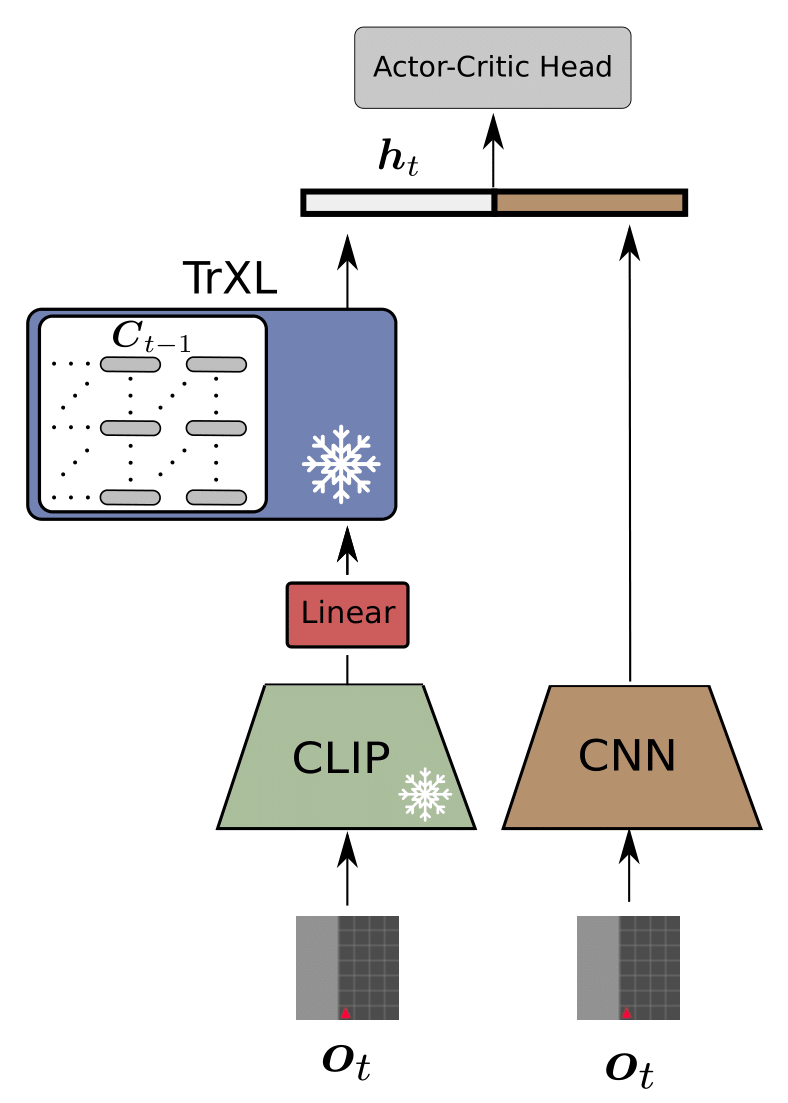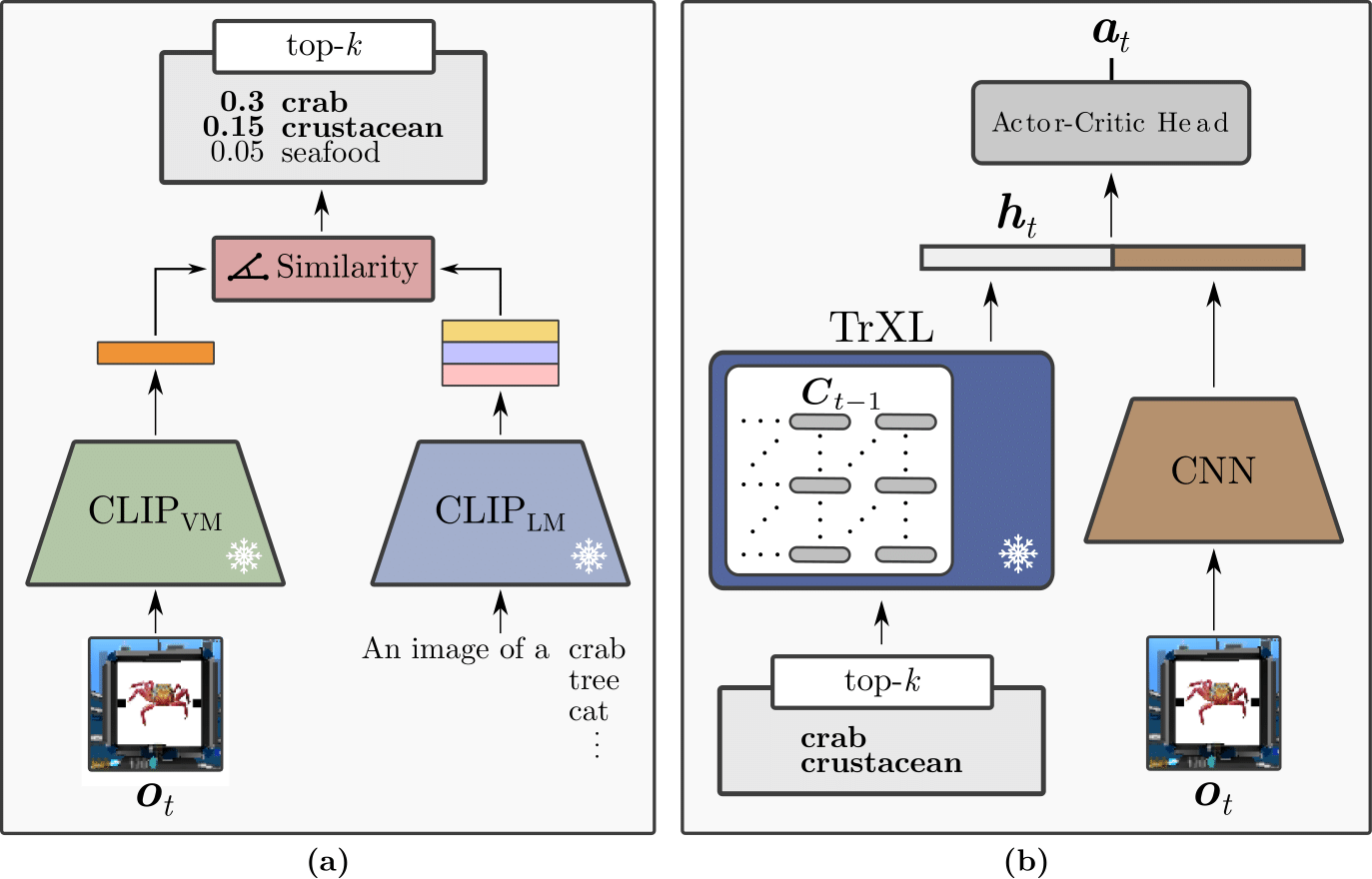This repository contains the code for the papers:
- History Compression via Language Models in Reinforcement Learning (HELM)
- Toward Semantic History Compression for Reinforcement Learning (HELMv2)
- Semantic HELM: An Interpretable Memory for Reinforcement Learning (SHELM)
Fabian Paischer1 2, Thomas Adler1, Vihang Patil1, Angela Bitto-Nemling1 3, Markus Holzleitner1, Sebastian Lehner1 2, Hamid Eghbal-zadeh1, Sepp Hochreiter1 2 3
1 LIT AI Lab, Institute for Machine Learning, Johannes Kepler University Linz, Austria
2 ELLIS Unit Linz
3 Institute of Advanced Research in Artificial Intelligence (IARAI)
HELM leverages pretrained language encoders as a memory component for partially observable environments. Thereby, it uses a modern Hopfield Network to map observations to language tokens.
A detailed blog post on HELM is available at this link.
To reproduce the HELM baseline, first clone the repository and install the conda environment by
git clone https://github.com/ml-jku/helm.git
cd helm
conda env create -f env.yml
After installing the conda environment you can train HELM on the KeyCorridor environment by
python main.py
A new directory ./experiments/HELM/MiniGrid-KeyCorridorS3R1-v0 will be created in which all log files and checkpoints will be stored.
All changeable parameters are stored in the config.json file and can be adjusted via command line arguments as:
python main.py --var KEY=VALUE
For example, if you would like to train on RandomMaze-v0:
python main.py --var env=RandomMaze-v0
or on the Procgen environment maze:
python main.py --var env=maze
Note that by default the Procgen environments are created in the memory distribution mode, thus only the six environments as mentioned in the paper can be trained on, all others do not support the memory mode. By default a Tensorboard log is created.
Fabian Paischer1 2, Thomas Adler1, Markus Hofmarcher1 2, Andreas Radler 1, Sepp Hochreiter1 2 3
1 LIT AI Lab, Institute for Machine Learning, Johannes Kepler University Linz, Austria
2 ELLIS Unit Linz
3 Institute of Advanced Research in Artificial Intelligence (IARAI)
HELMv2 replaces the random projection of HELM with a pretrained CLIP encoder. Further it employs ad adopted and fixed batchnorm layer to project the visual observations to the language space. The mapping to the language space for HELM and HELMv2 are arbitrary, i.e., no semantics are transferred to the language space.
You can find the trainer file for HELMv2 here.
To reproduce our results on the MiniGrid environments, simply run
python main.py --var model=HELMv2 --var env=MiniGrid-RedBlueDoors-6x6-v0
To run HELMv2 on the MiniWorld benchmark suite you will first need to install gym-miniworld from source:
git clone https://github.com/maximecb/gym-miniworld.git
cd gym-miniworld
git checkout ff61a67
pip3 install -e .
Note that it is vital to check out and install the specified commit from source, since the MiniWorld benchmark suite has undergone significant changes ever since. Then, to run HELMv2 on MiniWorld simply specify the MiniWorld environment as follows:
python main.py --var model=HELMv2 --var env=MiniWorld-Sign-v0
You can find a comprehensive list of MiniWorld environments here. If you encounter problems for training on MiniWorld (NoSuchDisplayException)
xvfb-run -a -s "-screen 0 1024x768x24 -ac +extension GLX +render -noreset" python main.py --var model=HELMv2 --var env=MiniWorld-Sign-v0
More details regarding troubleshooting can be found here.
If you are interested in the semantic mappings from image to text space introduced in Toward Semantic History Compression for Reinforcement Learning (HELMv2), please also check out this repo which uses these mappings for image-conditioned text generation.
Fabian Paischer1 2, Thomas Adler1, Markus Hofmarcher1 2, Sepp Hochreiter1 2 3
1 LIT AI Lab, Institute for Machine Learning, Johannes Kepler University Linz, Austria
2 ELLIS Unit Linz
3 Institute of Advanced Research in Artificial Intelligence (IARAI)
Semantic HELM utilizes a retrieval mechanism via a pretrained CLIP model to encode an image in the language space. Particularly, we use the vocabulary of the CLIP language encoder as our semantic database and augment each token with a set of prompts. Then, we retrieve corresponding tokens given a visual observation as input. Finally, the text-tokens are fed into the language encoder and represent the memory of an agent. The memory module of SHELM is intrinsically interpretable, which allows identifying failure cases and facilitates troubleshooting. SHELM significantly outperforms HELM, HELMv2, and Dreamerv2 on environments that are unsolvable without a memory component.
To run experiments with SHELM, you will need to extract the CLIP embeddings for the different environments first, by running
python prepare_embeddings.py
This will store prompt-augmented CLIP embeddings for the different environments, as well as a mapping for tokens appearing in both, the vocabulary of CLIP, and the TrXL in the data/ directory.
After doing so, you can run SHELM by setting --var model=SHELM on any of the aforementioned environnments.
In order to reproduce our runs on the Psychlab Continuous Recognition task you will need to download and install deepmind_lab first. Then, you will need to download the dataset contianing the stimuli used by the continuous recognition environment by executing
cd data/brady_konkle_oliva2008
./download_data.sh
Finally, set the DATASET_PATH in ENV_DIR/lib/python3.8/site-packages/deepmind_lab/baselab/game_scripts/datasets/brady_konkle_oliva2008.lua to the directory containing the images.
ENV_DIR corresponds to the path of your conda environment.
Now you can set --var env=psychlab_continuous_recognition to train on the continuous recognition task.
If you encounter issues while trying to run the psychlab tasks (Failed to connect RL API), you will need to install sdl2 for headless rendering:
conda install -c conda-forge sdl2
You can find all hyperparameters for our psychlab experiments in the paper.
For running experiments on Avalon we used the official codebase of the Avalon environment, which you can find here. We will also add the code for these experiments soon.
We added all configs for MiniGrid/MiniWorld/Psychlab experiments in the configs directory.
To reproduce a result in the paper, simply load the corresponding config via the --config command line argument of the main.py script.
To run a trained policy make sure to first set the --var save_ckpt=1 argument during training.
This stores the best checkpoint in the experiments directory.
To sample episodes from a trained policy you can then simply execute
python eval-py --ckpt-path PATH_TO_CKPT_DIR
- All results on Psychlab, Avalon, MiniGrid/MiniWorld
- Visualization of tokens being fed into the memory
- Support for Avalon environment
- Support for BERT-style language encoders
- Inference speedup for HELM-like models
MIT LICENSE
If you find our papers and code useful, please consider citing HELM,
@InProceedings{paischer2022history,
title = {History Compression via Language Models in Reinforcement Learning},
author = {Paischer, Fabian and Adler, Thomas and Patil, Vihang and Bitto-Nemling, Angela and Holzleitner, Markus and Lehner, Sebastian and Eghbal-Zadeh, Hamid and Hochreiter, Sepp},
booktitle = {Proceedings of the 39th International Conference on Machine Learning},
pages = {17156--17185},
year = {2022},
editor = {Chaudhuri, Kamalika and Jegelka, Stefanie and Song, Le and Szepesvari, Csaba and Niu, Gang and Sabato, Sivan},
volume = {162},
series = {Proceedings of Machine Learning Research},
month = {17--23 Jul},
publisher = {PMLR},
pdf = {https://proceedings.mlr.press/v162/paischer22a/paischer22a.pdf},
url = {https://proceedings.mlr.press/v162/paischer22a.html},
abstract = {In a partially observable Markov decision process (POMDP), an agent typically uses a representation of the past to approximate the underlying MDP. We propose to utilize a frozen Pretrained Language Transformer (PLT) for history representation and compression to improve sample efficiency. To avoid training of the Transformer, we introduce FrozenHopfield, which automatically associates observations with pretrained token embeddings. To form these associations, a modern Hopfield network stores these token embeddings, which are retrieved by queries that are obtained by a random but fixed projection of observations. Our new method, HELM, enables actor-critic network architectures that contain a pretrained language Transformer for history representation as a memory module. Since a representation of the past need not be learned, HELM is much more sample efficient than competitors. On Minigrid and Procgen environments HELM achieves new state-of-the-art results. Our code is available at https://github.com/ml-jku/helm.}
}
and SHELM
@article{paischer2023semantic,
author = {Fabian Paischer and
Thomas Adler and
Markus Hofmarcher and
Sepp Hochreiter},
title = {Semantic {HELM:} An Interpretable Memory for Reinforcement Learning},
journal = {CoRR},
volume = {abs/2306.09312},
year = {2023},
url = {https://doi.org/10.48550/arXiv.2306.09312},
doi = {10.48550/arXiv.2306.09312},
eprinttype = {arXiv},
eprint = {2306.09312},
timestamp = {Mon, 19 Jun 2023 11:06:52 +0200},
biburl = {https://dblp.org/rec/journals/corr/abs-2306-09312.bib},
bibsource = {dblp computer science bibliography, https://dblp.org}
}


